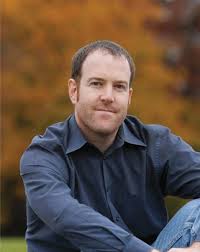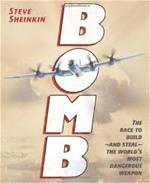 A reformed textbook writer, Steve Sheinkin has dedicated his recent career to making up for his previous sins by writing gripping narratives that would never make it past the school board. He is the author of several fascinating books on American history, including The Notorious Benedict Arnold, which won the Boston Globe/Horn Book Award for nonfiction. His latest work, Bomb: The Race to Build—and Steal—The World's Most Dangerous Weapon, was released earlier this week.
A reformed textbook writer, Steve Sheinkin has dedicated his recent career to making up for his previous sins by writing gripping narratives that would never make it past the school board. He is the author of several fascinating books on American history, including The Notorious Benedict Arnold, which won the Boston Globe/Horn Book Award for nonfiction. His latest work, Bomb: The Race to Build—and Steal—The World's Most Dangerous Weapon, was released earlier this week.
Bomb: The Race to Build—and Steal—The World's Most Dangerous Weapon is the story of the world’s first nuclear weapon. What makes this book a “global thriller,” as you’ve dubbed it?
Well, it’s got nonstop action and a cast of characters no novelist could invent, and the scenes speed around the world, from Berlin to Washington, D.C., from Moscow to the deserts of New Mexico. I love spy thrillers, novels I mean, and my goal was to try to recreate that almost dizzying pace, but to do it as nonfiction.
Bomb ends on a cautionary note about our nuclear future. How do you hope this book affects students’ notions of war and weaponry?
Unfortunately, this is an issue that’s not going to go away. I think students need to know about nuclear weapons—how and why they were originally made, how dangerous they are, who has them, who is trying to get them. Discussing and debating the decision to use atomic bombs in World War II can help students think about how such decisions should be handled in the future.
It would be nice to think we won’t face this question again, but that’s probably not realistic.
 In Bomb, as in your other narrative nonfiction, you write about people and events that aren’t usually included in textbooks. How do you find the quirky or little-known facts that make your stories unique?
In Bomb, as in your other narrative nonfiction, you write about people and events that aren’t usually included in textbooks. How do you find the quirky or little-known facts that make your stories unique?
Like I tell students at school visits, I think of myself as a kind of detective. Okay, it’s a nerdy sort of detective work, but still… I find an interesting story or character in one source, and that becomes a kind of clue. I’ll follow the clue to other sources: books, journals, interviews, letters, wherever the facts lead.
I spend more time researching than actually writing, and I always end up with way more stories than I can cram into any one book. That’s the saddest part of the job—having to cut cool stuff because it just doesn’t fit.
On your homepage you confess that you used to write text books, but that you now “write history books that people will actually read voluntarily.” How do you bring life and excitement to material that might otherwise be considered boring and “academic”?
Really, history is just stories about people and dramatic events, so there’s nothing inherently boring about it. The problem is, if all kids know about history comes from textbooks, they think history is boring. So my job is to bust through the resistance by telling exciting and entertaining stories.
I try to take all the sources I find and craft the material into scenes, just like you’d do if you were making a movie. Hopefully, readers will have so much fun reading the book, they’ll forget they’re supposed to be learning. That’s what I’m going for with BOMB.
You also write regularly for the Interesting Nonfiction for Kids blog. What’s the goal of the site, and how do you work to achieve it?
That’s a great site, because it offers an inside look at the working process of all these different writers of non-fiction. Writers blog about research they’re doing, challenges they face in the work, upcoming projects, the craziness of the publishing world, and more.
When I contribute entries, I like to share obscure stories I’ve come across in my research, stuff that may never make it into any book. Basically, those of us who write nonfiction are convinced that true stories are every bit as fun and exciting to read as fiction, and the INK blog helps us prove it!